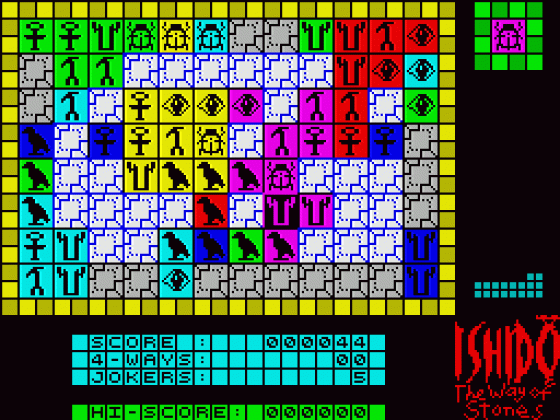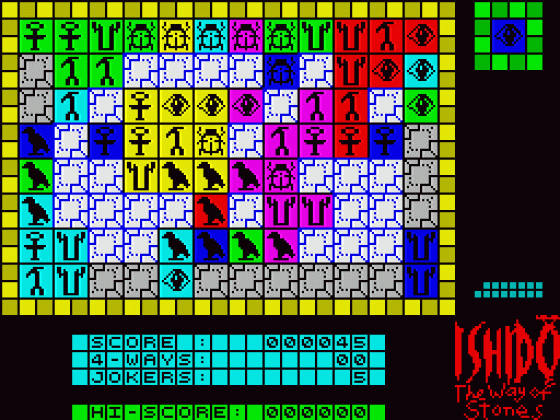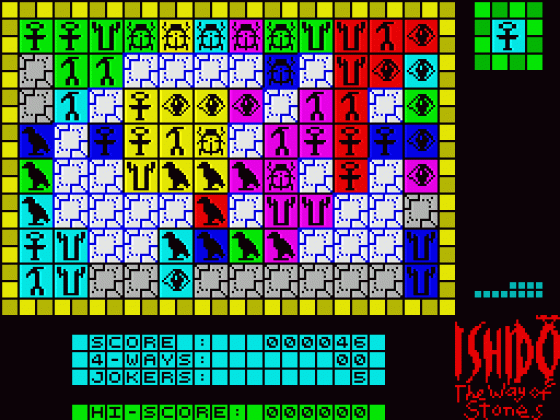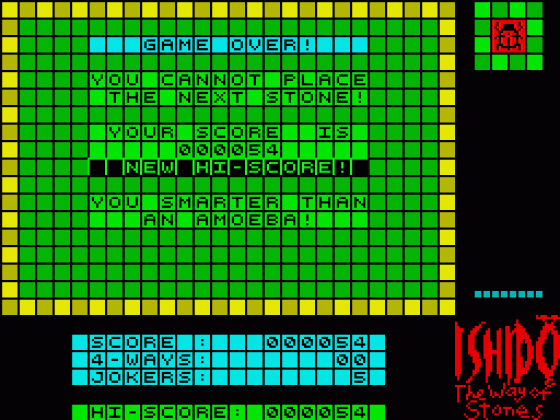Alternative Games Called Ishido: The Way Of Stones
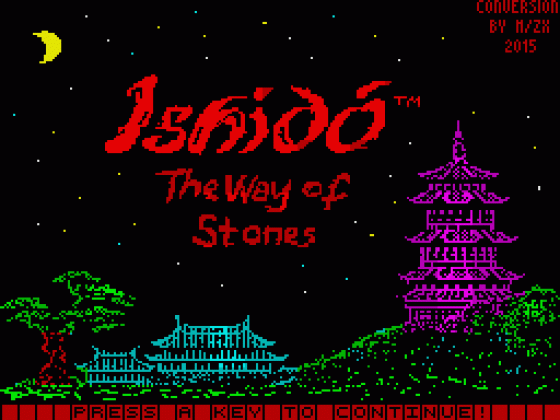

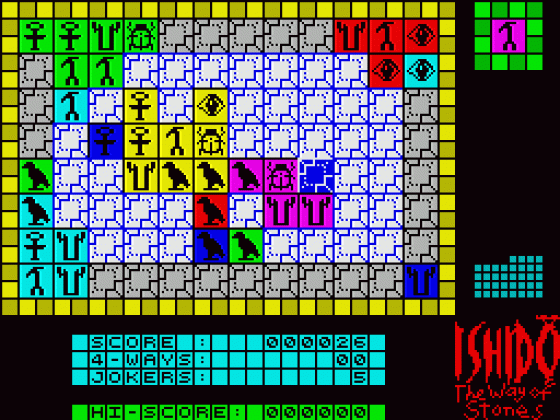


| Genre: | Unknown Genre Type |
| Publisher: | Mezei Robert |
| Cover Art Language: | English |
| Machine Compatibility: | Spectrum 48K, Spectrum 16K |
| Release: | Professionally released on Cassette |
| Available For: | Amiga 500, Amstrad CPC464, Evercade, Game Boy, Nintendo, PC-88, Sega Genesis & Spectrum 16K/48K/Plus/128K |
| Compatible Emulators: | ZXSpin (PC (Windows)) Nutria (PC (MS-DOS)) |
| Original Release Date: | 1st October 2015 |
| Original Release Price: | Unknown |
| Market Valuation: | £2.50 (How Is This Calculated?) |
| Item Weight: | 64g |
| Box Type: | Cassette Single Plastic Clear |
| Author(s): | Mezei Róbert |
Variant Items
There are 4 other items featuring this same game (that we know about!). Click any of them for their details.
Active Auctions
Closed Auctions
Buy It
Unfortunately no-one is currently selling this item.
Auction Price Watch
Worried you're being ripped off? Closing prices on eBay can help you decide what a reasonable price is for a particular item.
Full Instructions
The Legend Of Ishido
One misty spring morning in 1989, in the remote mountains of China's Han Shan province, a mendicant monk of the Northern School of the White Crane branch of Taoism walked silently out through the front gates of the Heavenly Peak Temple. The priest carried with him a stone board, a set of 72 carved stone pieces, and an ancient scroll inscribed with brush and ink in elegant calligraphic script. He also carried with him a secret which had lain cloistered and hidden for thousands of years.
Gameplay
From the first move of this ancient game and beautiful puzzle your deepest powers of strategy and concentration will be called upon as you match 72 stones on a board of 96 squares.
Stones & Game Board
A stoneset consists of 72 stones. Every stone has two a color and a symbol. There are 6 colours and 6 symbols in each stoneset, thus creating 36 unique stones. Each stone comes in a pair, hence 72 stones in each stoneset. The Game Board is 8 squares high by 12 squares wide.
The "Beyond" is the dark squares around the outer edges of the board, and the "Within" consists of the light interior squares. Only stones placed in the Within score points. Stones placed in the Beyond do not score points, but are strategically valuable.
The Touchstone displays the next stone to be played (the upper right corner). The Scoreboard (under the Table) shows the number of points scored, the number of 4-Way matches achieved, the number of jokers, and the highest score, which you reached since the loading of the game.
The Pouch shows a representation of the number of stones remaining to be played (under the Touchstone). It is possible to see the actual stones and their order of play by pressing Caps Shift + P hotkey (this takes away a joker).
To begin play, select '1 � Start new game' in menu. The game begins with the unique opening tableau of six stones on the board and a pouch of randomly ordered stones. The opening tableau consists of stones placed at each of the four corners and at two centre squares. Each of the 6 symbols and 6 colours are represented.
The basic objective of the game is to empty the pouch of stones, placing them all on the board. Certain rules must be followed, and the more "4-Way Matches" that are achieved, the better the game.
The game ends when a stone cannot be placed legally or the entire pouch of 72 stones has been emptied.
Rules
Stones are placed on the board, one at a time, after first being displayed on the Touchstone. The stone is placed from the Touchstone to the board by pointing the cursor at the square where the stone is to be placed and then pressing the fire button.
Each stone must be placed adjacent (above, below, to the left or right - not diagonal) to another stone.
A stone can only be placed beside another stone when the two stones have at least one of the two attributes in common.
If a stone is placed such that its sides are adjacent to two other stones (2-Way match), it must match a different attribute in each of those two stones (symbol of one, colour of the other). The same attribute cannot be used to match both adjoining stones.
A 3-way match requires each of the two attributes to be present.
A 4-way match, when a stone is placed in the centre of four other stones, requires matching two of the stones with one attribute and matching the other two with the second attribute. 4-way matches are rare, and it takes practice to learn how to create them. Yet, they are desirable and a primary goal of the game.
Jokers
During the game you can use up to five jokers. You may use the joker for four things:
Show hint (Caps Shift-H)
This shows the possible places of the next stone
Show pouch (Caps Shift-P)
This shows the order of the stones in the pouch
Remix pouch (Caps Shift-R)
This remixes the pouch, change the order of stones
Undo the last step (Caps Shift-U) You may undo your last step, two times after each other cannot be used.
Scoring
Scoring for a legal match is determined by the number of sides the stone touches other stones (above, below, left, right) as it is played:
- 1 point for matching a single side
- 2 points for a 2-Way (two-sided) match
- 4 points for a 3-Way (three-sided) match
- 8 points for a 4-Way (four-sided) match
When a 4-Way is made, a bonus is paid and the points made for subsequent matches are thereafter doubled (i.e. after the first 4-Way is scored, a single-sided match is now worth 2 points, a 2-Way is given 4 points, a 3-Way is scored 8 points and a 4-Way is worth 16. After the second 4-Way this is again doubled, and so on).
Bonus points paid are:
- 25 points for the 1st 4-Way
- 50 points for the 2nd 4-Way
- 100 points for the 3rd 4-Way
- 200 points for the 4th 4-Way
- 400 points for the 5th 4-Way
- 600 points for the 6th 4-Way
- 800 points for the 7th 4-Way
- 1,000 points for the 8th 4-Way
- 5,000 points for the 9th 4-Way
- 10,000 points for the 10th 4-Way
- 25,000 points for the 11th 4-Way
- 50,000 points for the 12th 4-Way
There is a bonus given at the end of the game when there are fewer than three stones left in the pouch:
- 100 points with 2 stones left
- 500 points with 1 stone left
- 1000 points if the pouch is emptied
Strategy
The basic strategy for playing and winning Ishido revolves around emptying the pouch (playing all of the stones to the board) and accumulating 4-way matches.
The obvious strategy to emerge is two-fold:
- Play for 4-Ways as early and as often as possible
- Utilise all four corners and the centre of the board in making 4-ways
- Remember that there is a major bonus for emptying the pouch
Making The Basic 4-Way
From any chosen stone, the 4-way is started by playing a stone matching the colour on one of the sides and a stone matching the symbol above or below the original stone.
Beginning Moves
For example, say that the stone in the bottom right corner of the screen is a yellow stone with a circle, and that a yellow stone with a square is displayed on the touchstone.
By placing the yellow stone with a square to the left of the yellow stone with the circle the colour attribute is determined for this potential 4-way.
Now, a couple of moves later, a blue stone with a circle is displayed. The player should place this stone above the yellow stone with the circle, therby determining the other attribute (circle).
At this point the player is beginning to establish a 4-way where the final stone will be a yellow stone with a circle.
At least four additional moves must be made before the 4-way set-up is ready for the final stone to be set in place.
Note: The player could choose at this time to make a 4-way where a blue stone with a square is the final stone. However, it is better as a beginner to make an early decision as to what final stone you are working toward.
Positioning Moves
The next time a stone with a circle is drawn, it should be placed above the blue stone with a circle, and then the next circle should be placed to the left of that stone.
This creates two sides of the forming 4-way above the original corner stone.
Likewise, the next time a yellow stone of any symbol is drawn, it should be placed to the left of the yellow stone with the square, and finally, the next yellow stone would be placed above the previously played yellow stone.
Waiting For The Centre Stone To Be Drawn
With the placing of this final stone, a square has been created at the right bottom of the screen with three yellow stones to the left of the original stone, three stones with circles above it, and a blank space in the middle (diagonal to the original stone) empty.
The only stone that will fit in the centre to complete the 4-way is a yellow stone with a circle, the stone that matches the original corner stone (remember that there are two of each stone).
Note: If the remaining yellow stone with a circle is displayed on the touchstone prior to the final set-up of the 4-way it would not be possible to complete the 4-way.
This is where chance (and patience) is involved in achieving 4-way matches.
Note: As the player improves in skill, strategies for creating 4-ways that allow for a different stone (than the one originally planned) to be placed in the centre will be developed.
This is where skill takes a hand in the player's ability to score highly.
Example: Beginning and positioning moves, and finally, the complete 4-Way in right bottom corner
[]
Centre Master Play
The two centre stones offer the best opportunity for creatng 4-ways since it is possible to create four 4-ways around these two stones.
Stones matching the attributes of the centre stones are played in such a way as to create four 4-ways surrounding the centre stones.
Example:
[]
Master Game
A Master Game is accomplished when eight 4-ways are made around each of the six opening stones including a Centre Master Play in the middle and the pouch is emptied.
Remember, it takes patience and skill to make 4-way matches and high scores with Ishido, but, whether or not you even attain the level of Master Player (having played three nine 4-way match games) you will have hours or fun and challenge as your skill increases to your level of commitment.
Menu Options
-
Start New Game
Your current game position is lost if you select this. -
Continue Game
You may continue the current game. -
Change Stoneset
You may choose from four different stonesets -
Blinking Cursor/Black Cursor
You may choose from two different cursor mode -
Change Board
You may choose from four different board patterns -
Game Controls
You can modify the control keys (first the left, then right, up, down, finally the fire button) -
Sound On/Off
According to the meaning
Game Controls
O - Left, P - Right, Q - Up, A - Down, SPACE - Fire
Hotkeys:
Caps Shift-M - Menu, Caps Shift-P - Show pouch, Caps Shift-R - Remix pouch
Caps Shift-H - Show hint, Caps Shift-U - Undo last step
Game Credits
Written by Mezei Robert
Tune from the Nintendo version of the Ishido
Tiles and loading screen come from the PC version of Ishido
Screen Designers
The following utilities are also available to allow you to edit the supplied screens of this game:
Cheats
Download
Report A Problem
We thank you from the bottom of our hearts if you report something wrong on our site. It's the only way we can fix any problems!
You are not currently logged in so your report will be anonymous.
Add Note
Release Country
Change the country to update it. Click outside of this pop-up to cancel.
Scan Of Selected Article
If you auction an item, it will no longer show in the regular shop section of the site.











